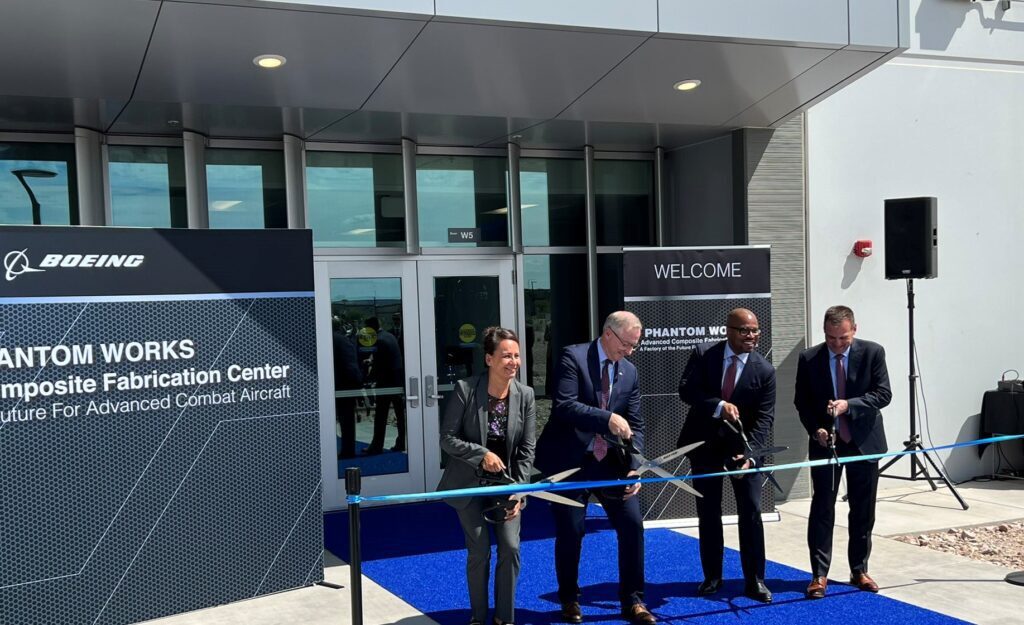
Boeing holds a ribbon cutting ceremony for its new Advanced Composite Fabrication Center in Mesa, Arizona. (Photo: Matthew Beinart.)
MESA, Ariz. — Boeing on Monday opened a new $150 million facility in Mesa, Arizona for producing advanced composite components for future combat aircraft programs, which is set to become fully operational later this fall.
The company said the 155,000-square foot secure Advanced Composite Fabrication Center (ACFC) will utilize the latest digital manufacturing approaches to provide “unprecedented speed, agility and cost efficiency” for its work on classified programs.
“This is all informed by the next generation of products, which have to be digital in their foundations to allow for flexibility and adaptability through a dynamic set of missions changing around the world,” Ted Colbert, CEO of Boeing Defense, Space and Security, told reporters ahead of a ribbon cutting ceremony for the new ACFC. “What you see today will help us deliver those next set of capabilities with advanced composite manufacturing capabilities. We believe it’s a really big and very important investment to us and we’re looking forward to seeing the results yield for our customers.”
Steve Nordlund, vice president and general manager of Boeing Phantom Works, said the new ACFC builds on best practices in new digital engineering and model-based design efforts utilized in the company’s development of the new T-7 advanced jet trainer, MQ-25 refueling drone and MQ-28 stealth drone in development for Australia.
“Now we go the next step further, how do we digitally start to inject that into the componentry and the system that is going to be needed in production,” Nordlund told reporters.” This is where digital becomes real. This is where the models of engineering that are so downright specific to a little screw, and that level of articulation in the model is being injected into robotic systems that build something. We highly believe that the future of all aerospace will be about a digital twin, a digital thread and driving it from the software to real hardware and that whole production.”
While Boeing noted it can’t disclose the programs that may be worked on at the ACFC, Nordlund said it will be key enabler of Phantom Works efforts on “the front end of the next capabilities coming down for our warfighter.”
“Everything’s on the table of how we leverage the facility. We’re not taking this facility and necessarily saying, again, it’s about this program or that program,” Nordlund said. “This facility here today is a real milestone for us to be able to point to something. We don’t get to point to a lot of things in Phantom Works. But this is something we get to point to talk about what the next generation of technology is coming to aid our customers and our warfighter.”
The ACFC is one of four new facilities Boeing is opening as it eyes future production work on advanced combat aircraft, with plans to also open a Specialized Lab and Test building, an Advanced Assembly Facility and Advanced Post-Assembly Center in St. Louis.
Boeing has invested “well over half a billion dollars” in the effort, Nordlund said.
Colbert was asked about Boeing placing a “big bet” in opening the facilities for programs to build new platforms down the road that the company has not won yet.
“We invest based on having knowledge of what the future mission set should be, could be and also based on the learnings we’ve had from prior platforms and using and leveraging the latest technologies to both build the platform and build the production system around the platform,” Colbert said. “Like you said, this is an investment for us and it is a bet. And we don’t know exactly what the future will be, but we do have a lot of depth and competence in these particular areas. We have a lot of confidence and understanding of what we think the future missions will be for the United States and our allies around the world. And we believe it’s our responsibility to make sure that we have offerings that would fit into any next set of missions, and that’s why we make the investment.”
Boeing was one of five companies the Air Force selected in August to work on the potential $975 million prototype phase of the Next Generation Adaptive Propulsion (NGAP) program, which the service is pursuing along with the Advanced Engine Transition Program (AETP) to power its future Next Generation Air Dominance (NGAD) platform.